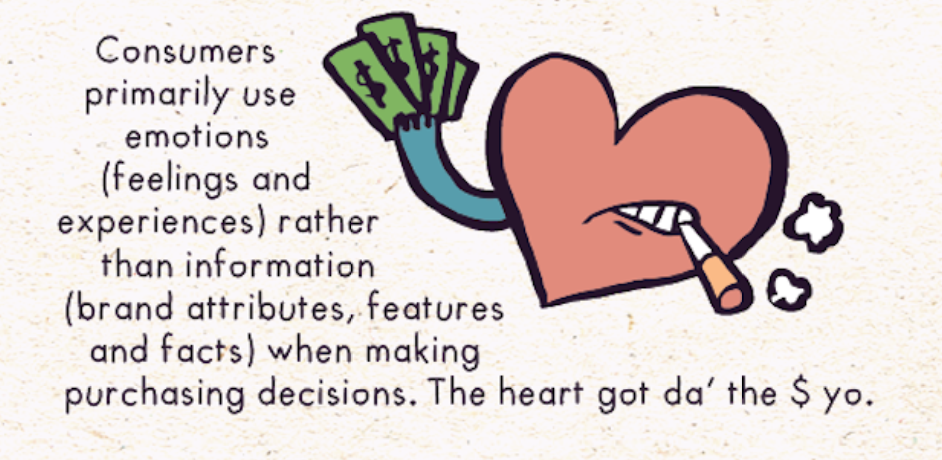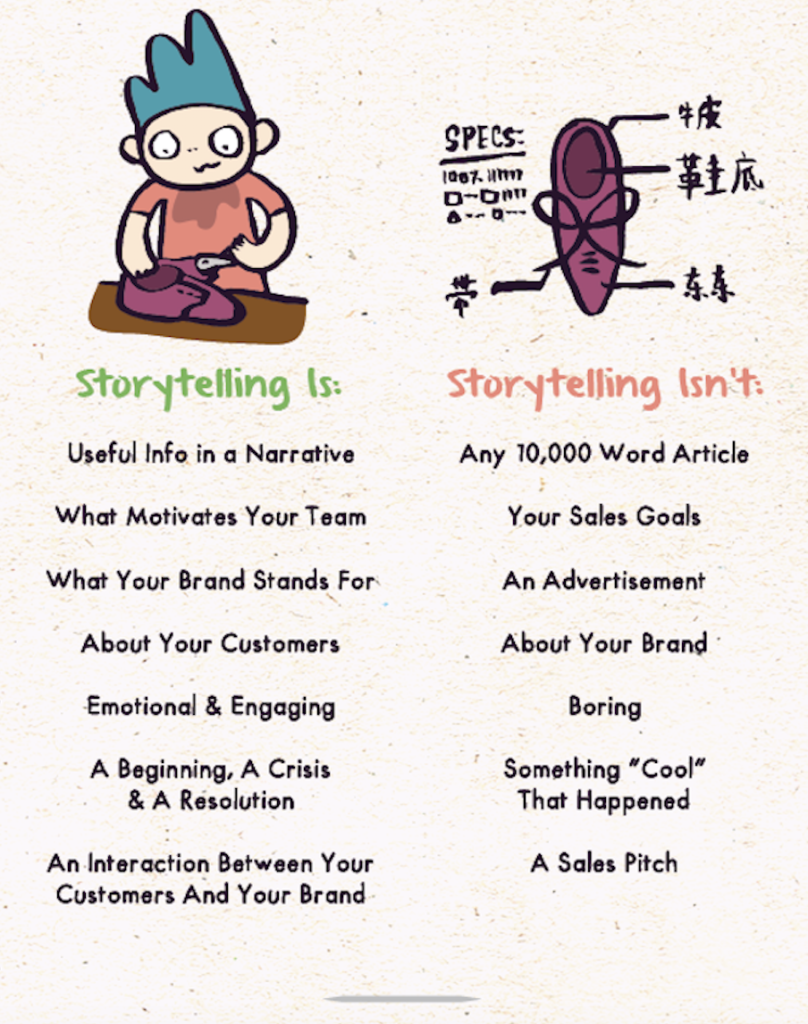By: Erin Joo
Storytelling is an asset that brands can utilize to differentiate itself from its competitors. How can a brand stand out through all the clutter and noise? Why will a consumer choose your brand over the similar brand sitting right next to it on the shelf? Will a promotional event catering company, who can help to market your brand in more ways than one, do the trick when it comes to driving your brand into the eyes of potential customers? Purchase decisions between products of identical quality and price can be swayed by effective storytelling. The ultimate goal of storytelling is to elicit emotion from the audience. When an emotional connection between a brand and consumer is created, it influences decision-making. In order to ensure this connection, a brand’s stories must be consistent, authentic, and relevant to the consumer.
In a well-known Ted Talk, bestselling author, Simon Sinek, describes a concept he calls the “Golden Circle“. This concept explains why companies with the same resources can have two very different fates: success or failure. The Golden Circle starts with the “why” which is the core belief of the business and why the business exists. The next layer is the “how” and elaborates on how the business fulfills that core belief. Lastly, the “what” is what the company does to fulfill that core belief. The common marketing mistake made by the companies that inevitably fail? The company starts with the “what” and ends with the “why”. Another mistake is for a company to not understand or know the “why” of the business (BIG problem). Consumers prioritize why a company does what it does which is the reason this needs to be the center of everything.
The next question is: what story should a brand tell? “A story is not just your history. A story is why you’re doing what you’re doing, and telling it in a way that appeals to your audience.” Brands can’t talk the talk without also walking the walk. A story cannot simply be a piece of social media content, it must also be integrated into the mission and value of a brand. There are three essential elements to storytelling: characters, conflict, and resolution. The characters should resonate with the target market so that they can see themselves as the character. Consumers will identify with characters which translates into identifying with the brand. Characters must be carefully chosen so that they personify the brand’s values and act as an extension of the brand as well. Next, conflict is important for building developmental and emotional dynamics. Finally, the resolution acts as a call of action to the audience and fulfills the purpose behind the story. Keep in mind that the story needs to be clear and concise so that messaging and purpose is not lost in translation.
It is also important to format the story visualization to the platform it’s being debuted on. This includes character count, image size, video size, video length, captions or no captions, etc. As we all know, social media platforms are not created equally. What works on Instagram will not work in the same way on Twitter. Variations of the same story may need to be made for different platforms. Although the content format is not exactly the same, the message and story itself remains consistent throughout. As I mentioned earlier, maintaining consistency is key to maximizing the impact of the story.
Now that I’ve spent all this time talking about the power of storytelling, what examples exist of this happening in the real-world? As we all know, storytelling is widespread among brand marketing today. So, who is doing it well? No surprise here. Nike. The three elements of this story are female athletes (character), gender inequality (conflict), and empowering females to break the mold and just do it even if it’s “crazy” (resolution). Let’s remember why Nike does what is does. Nike’s mission is to “bring inspiration and innovation to every athlete* in the world. *If you have a body, you are an athlete.” After watching this video, do you think Nike told the right story?
Instagram: @babyjooo
Twitter: @mserinjoo
LinkedIn: Erin Joo






Hi Erin,
I love that you mentioned Simon Sinek’s Ted Talk, “The Golden Circle.” I think he’s a pretty great speaker, and this particular Ted Talk perfectly aligns with your blog topic. You do a wonderful job providing links to sources throughout your post, and your use of media all seems very intentional. I especially appreciate your connection to Nike, followed by a video at the end. Thank you for writing about such a relevant topic!
Thanks for sharing this perspective on storytelling! It’s amazing ho helpful it can be in short form and long form to talk about your brand/mission. I think about storytelling a lot in terms of how nonprofits talk about their mission. To bring people IN, nonprofits use storytelling for just about everything–from fundraising to creating annual reports. The art is finding a way to tell the same story in less than 150 characters or in 150 words. Knowing the structure is key, as well as one’s audience!
If folks are interested in learning more about storytelling, they should RSVP for this storytelling workshop happening this Saturday on campus!: https://blogs.uoregon.edu/intertwined/
Hi Erin, Thank you so much for your post!. I really like that you talk about the “Golden Circle”, which I would do more research on it. It sure is very crucial for a company to start of with “why”, as I see many companies create a strategies evolving around “what” because they merely follow other people strategies without looking at their assets or their core value. I also like your example of Nike, which always do a very good job on recognizing their core value and their objective or their brands. They also do a very good job on picking their objective, which is resonated well with many people. According to the Youtube, I find myself resonate well with the video because they have point out the issues that all females would face one way or another in their life journey and most importantly it tied perfectly well with their objective of promoting a female athletes. Every single time I watch Nike commercial, I can’t help but feeling more engaging and admiring this brand. Lastly, I believe other brands should use Nike as their example to find affective Story Telling that would enhance their core value and impact.
Nice post Erin! Very true about brands and showing consistency with respect to the “why” regarding the core beliefs and existence of the business. I love that you mentioned Simon Sinek. You mentioning both Simon and consistency made me recall a piece of his that I saw on YouTube. I posted it below, you should check it out. He speaks about consistency in terms of genuine relationships and genuine leadership as the sum of acts over time. I believe the same can be applied to the “how” and the “what” that you mention regarding brand consistency. A brand can only stay true to its core purpose and identity by demonstrating its commitment to causes/beliefs through acts/messaging over a length of time. Great job!
I really like the idea of storytelling as a way for businesses and organizations to promote themselves. It can particularly be helpful for nonprofits, since there are almost always really heartfelt reasons for nonprofits to come into existence. I really like the way you framed this, as it was compelling and easy to understand. I think storytelling can be especially helpful when a well-known person is being promoted in the video or photo the business or organization is using. It can either make it relatable, or inspirational for the common follower.
I find it fascinating Erin that so many brands haven’t figured this out, or at least to the level of the great storytelling Nike. Yes, retail brands will inevitably have to share content that is product focused or talk about the innovations of a shoe for example. BUT that isn’t the main messaging that its trying to get across to consumers in regards to their affinity towards the brand. Big statement campaigns that align with consumer values like the Dove body image campaign or the Colin Kaepernick campaign are what keep these big brands relevant and liked by so many people. A brand has to stand for something these days and what better way to do that than through storytelling. Great piece!
Love this post, Erin! Good use of real-life examples and explaining what Nike does right in regard to storytelling. I like the simple, direct voice of the post.
Great post, Erin. I think you chose some interesting examples of how brands tell their stories effectively. Storytelling is so important, the first thing you’ll see on the SOJC website is “Great Storytelling Starts Here.” I think that Sinek’s “Golden Circle” Ted Talk was a great companion to this post. Thanks for sharing.
Hi Erin, I enjoyed reading your article! I like the examples you used, as they are very prominent in our society today, especially the Nike one. I think it’s important to keep storytelling alive, especially when it comes to brands and companies standing out and differentiating themselves from one another. I also enjoyed really watching the video at the end, as it really tied it all together nicely. Thank you for sharing!
Hi Erin,
I totally agree with how good storytelling makes a decision on a consumers choice of brand. Every powerful ad or campaign stands out to consumers and helps them make a decision on a brand. I think building a relationship with brands target audiences is key to becoming a successful brand. I really liked how you used the Nike example because it was super powerful and really connected with our society. I saw so many retweets and shares of this video because it was so impactful.
Hi Erin,
I really enjoyed your perspective on storytelling and the examples you provided. When I think of Nike’s recent commercials of “Believe in something even if it means sacrificing everything with Colin Kaepernick and the “dream crazier” with women athletes I think of storytelling. They are able to capture a story or a message in just a minute that inspires people to shop and wear their brand. I never realized how powerful storytelling can be until I looked at from this perspective. Really interesting stuff!
Erin, really great post – I can tell you worked hard on this! I think storytelling has become a “must-have” for brands in order to fully connect with and engage their consumer base. Even for product companies, connecting with consumers on an emotional level, versus simply spewing product details, has been proven to ultimately provide more value to the brand as consumers are more likely to feel connected and want to buy. Nike has and continues to do a great job at this. It seems rare to see a Nike commercial that features a certain product. Instead, they feature stories that grip the hearts of consumers and build a brand connection that ultimately carries over to the buying decision
Great post Erin. The real life examples are cool to see highlighted. The importance of story telling is paramount in today’s business (and social) climate. You are spot on with all of your thoughts about how brands need to build that authentic connection with a business to continue generating revenue. Good stuff.